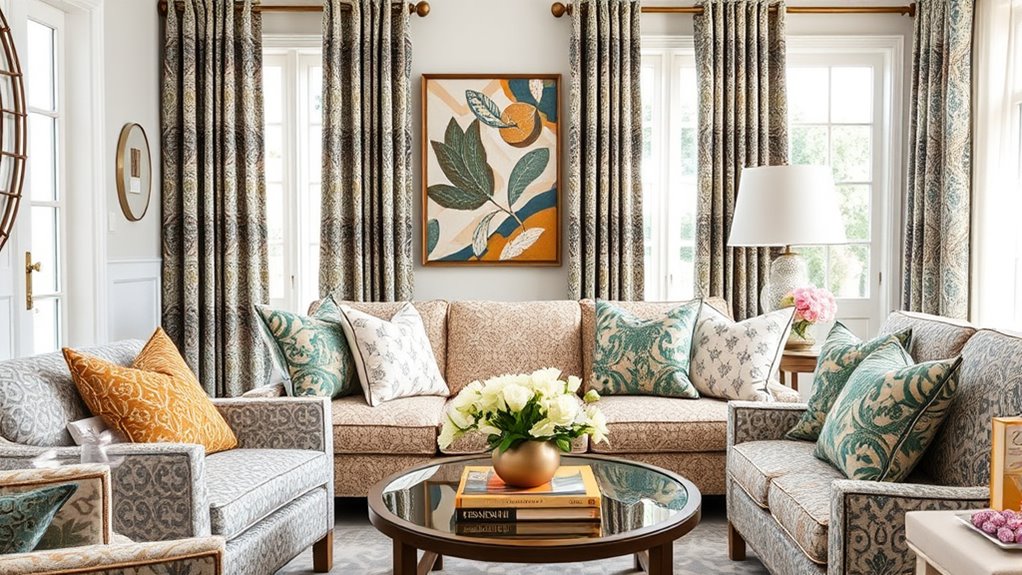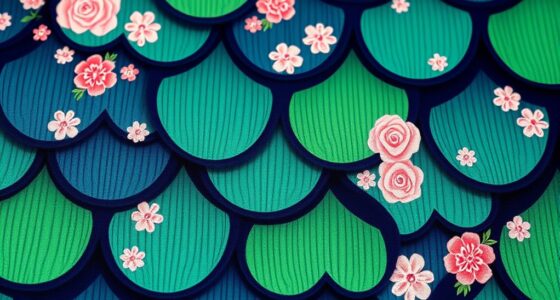To avoid overcrowding when using patterned fabrics, choose one dominant pattern and complement it with smaller or subtler designs. Limit your palette to two or three styles, balancing busy patterns with solid colors. Play with different scales and textures to add visual interest without clutter. Incorporate patterns in small doses, like pillows or accents, and guarantee proper placement for harmony. Keep refining your layout to create a cohesive, stylish space—more tips await if you keep exploring.
Key Takeaways
- Limit the number of patterns to two or three styles for a balanced look.
- Mix bold patterns with solids or subtle designs to prevent visual overload.
- Vary pattern scale and size to create contrast and visual interest without clutter.
- Use neutral or solid-colored accessories to anchor busy patterned areas.
- Incorporate textures alongside patterns to add depth without increasing visual chaos.
Choose a Dominant Pattern and Complementary Accents
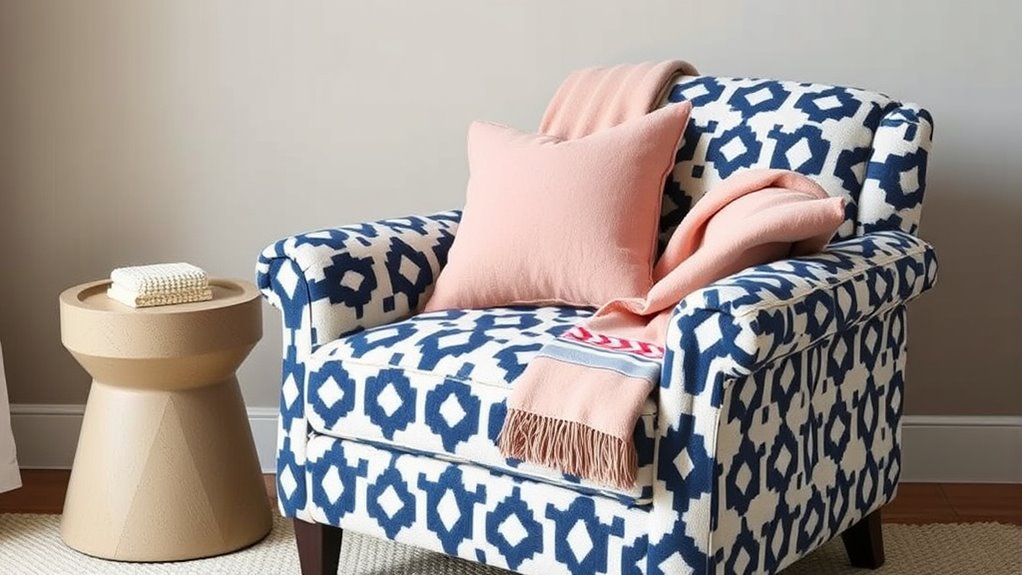
When selecting a patterned fabric, it’s essential to identify a dominant pattern that sets the tone for the space. This pattern will anchor your design and guide your pattern coordination. Choose a bold or large-scale print as your main piece, such as a sofa or curtains, to create visual interest without overwhelming the room. Once you’ve picked your dominant pattern, incorporate complementary accents with smaller or subtler patterns, ensuring they work well together through fabric mixing. Keep the color palette consistent to avoid clashing. The key is balancing the dominant pattern with supporting fabrics that enhance rather than compete. Additionally, understanding AI’s role in design can help optimize your fabric choices and pattern combinations. This approach allows you to create a cohesive, visually appealing space while maintaining a lively, layered look.
Limit Your Pattern Palette to Two or Three Styles
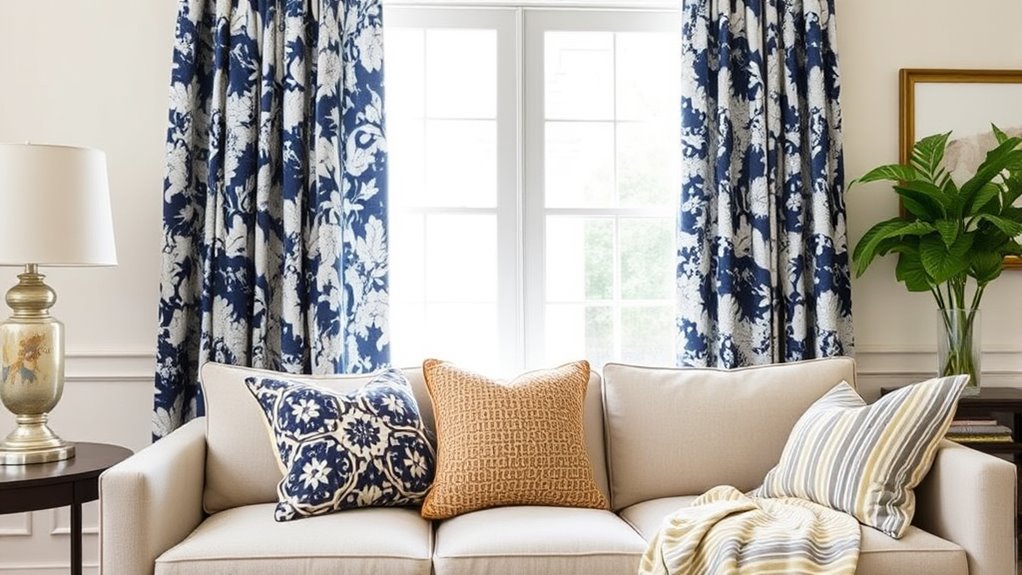
To keep your space balanced, stick to just two or three pattern styles. Carefully mix similar patterns to avoid visual clash, and use solid colors to create breathing room. This approach helps your patterned fabrics work together instead of competing for attention. Incorporating diverse design options can further enhance your interior aesthetic while maintaining harmony.
Stick to Two or Three
Limiting your fabric patterns to two or three styles creates a cohesive and balanced look. When you stick to this small palette, it helps prevent pattern clash and makes fabric layering easier to manage. You’ll find that your space feels intentional and inviting, rather than chaotic or overwhelming. To make this even clearer, consider this table:
| Pattern Style 1 | Pattern Style 2 | Pattern Style 3 |
|---|---|---|
| Stripes | Florals | Geometrics |
| Bold | Soft | Structured |
| Versatile | Playful | Modern |
Choosing just a few styles allows you to mix and match confidently, knowing each piece complements the others. Keep your palette simple, and your patterned fabrics will work together harmoniously, avoiding clutter and creating a stylish, curated look. Incorporating a color scheme can further enhance the cohesiveness and visual appeal of your fabric combinations.
Mix Similar Patterns Carefully
Mixing similar patterns can create a sophisticated look, but it requires a careful approach to avoid visual chaos. To master pattern matching, select designs with complementary scales and color schemes. For instance, pair a floral print with subtle stripes or checks that share similar hues. Focus on fabric coordination by balancing busy patterns with calmer, simpler fabrics. Keep your pattern palette limited to two or three styles to prevent overwhelming the space. When combining patterns, consider the orientation and scale to ensure they complement each other rather than compete. Use accessories or smaller accents to tie the look together subtly. Remember, the goal is harmony—carefully matching patterns creates visual interest without overcrowding your design. Additionally, paying attention to visual balance helps maintain an appealing and cohesive overall appearance.
Use Solid Colors for Balance
Incorporating solid colors alongside patterned fabrics creates visual breathing space and prevents your design from feeling cluttered. When fabric mixing, sticking to a limited pattern palette—just two or three styles—helps maintain harmony and avoids pattern clashing. Solid colors act as neutral anchors, balancing busy prints and giving your eyes a place to rest. This simplicity ensures that the patterns stand out without overwhelming your space. Limit the number of patterns you introduce, and choose solids that complement or match your patterns’ colors. By doing so, you create a cohesive look that feels intentional rather than chaotic. Remember, less is more; a carefully curated mix of solids and patterns results in a stylish, balanced design that’s pleasing and well-coordinated. Additionally, understanding visual harmony principles can help you craft more aesthetically pleasing combinations.
Balance Patterned and Solid Elements Effectively
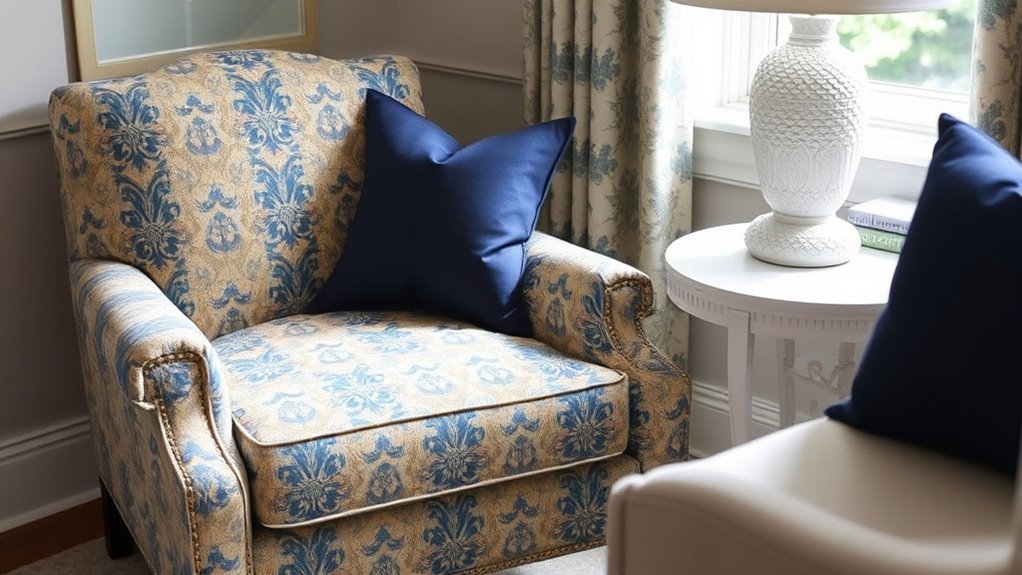
To create a balanced look, mix different pattern scales and sizes so they complement rather than compete. Incorporate solid color accents to give your patterned fabrics room to breathe and prevent visual overload. By thoughtfully combining these elements, you can achieve a cohesive and inviting space. Additionally, considering material durability can ensure your fabrics maintain their appearance over time.
Mix Scale and Size
Balancing the scale and size of patterned and solid elements is key to creating a cohesive and visually appealing space. Using large-scale patterns can add drama, but too many may cause pattern clash. Conversely, smaller patterns can complement solid fabrics without overwhelming the room. Varying the size of patterns prevents visual fatigue and highlights different areas. Consider fabric durability when selecting patterns—delicate designs may not withstand heavy use. Mix big motifs with subtle solids to anchor the space. Keep pattern sizes proportional to furniture and room dimensions for harmony. Additionally, understanding support hours for your favorite entertainment venues can help plan visits without time conflicts.
Use Solid Color Accents
Solid color accents serve as essential anchors in a patterned space, helping to ground and balance the overall design. They create a visual pause amid busy pattern layering, preventing the room from feeling overwhelming. Incorporate elements like solid throw pillows, rugs, or curtains to introduce texture contrast, which enhances depth without competing with patterns. These accents help you control the visual weight, drawing attention to specific areas while maintaining harmony. By thoughtfully choosing solid colors that complement your patterned fabrics, you establish a cohesive flow. Using solid accents also offers flexibility—you can easily swap them out to refresh the space. Resources and Tools such as color palettes and material guides can assist in selecting the right accents. This approach ensures your room remains lively yet balanced, making patterned fabrics feel intentional rather than chaotic.
Use Scale and Size to Create Visual Harmony
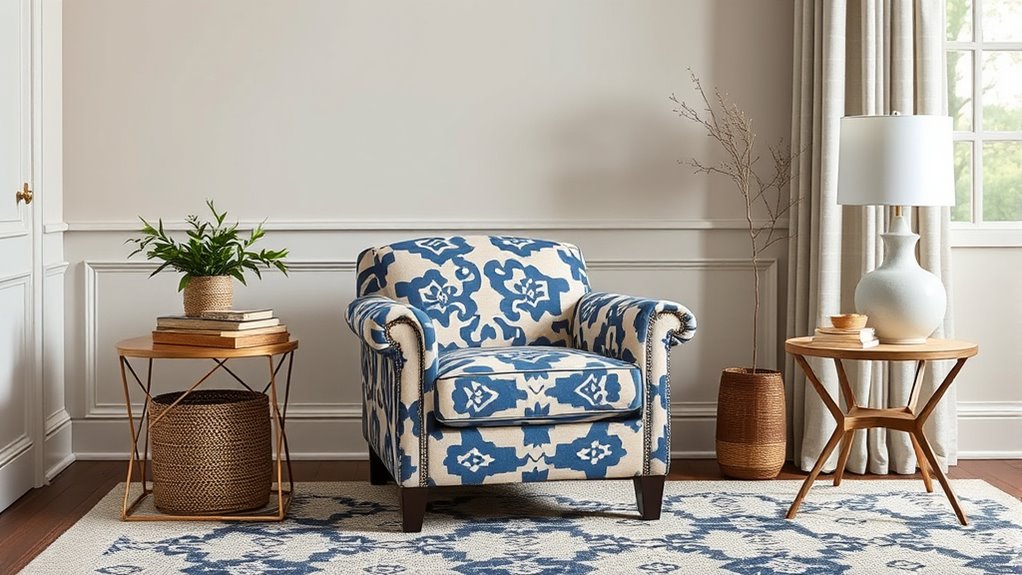
When working with patterned fabrics, using scale and size effectively can make all the difference in achieving visual harmony. Large patterns draw attention and create bold statements, while smaller patterns add subtle texture. To balance pattern contrast, pair big prints with solid or smaller designs, avoiding overwhelming the space. Consider fabric texture as well: smooth fabrics work well with busy patterns, while textured textiles can add depth without competing. Play with scale to guide the eye and maintain cohesion. Additionally, paying attention to pattern placement can enhance the overall aesthetic and create a more polished look.
Mix Patterns With Different Textures for Depth

Adding different textures to patterned fabrics creates visual interest and depth in your space. Incorporate textural contrast by pairing smooth, glossy fabrics with tactile, woven materials. This variation enhances pattern hierarchy, making each fabric stand out without overwhelming the room. For example, combine a velvet pillow with a linen throw or a silk curtain with a textured rug. These contrasts draw the eye and add dimension, preventing your decor from feeling flat or cluttered. When mixing patterns, focus on balancing textures to highlight individual designs while maintaining cohesion. This approach creates a layered look that’s rich and inviting. Additionally, understanding the properties of different fabrics, such as cooking – Turtle Tree Seeds, can inspire creative pairing choices that reflect both texture and function. By thoughtfully combining textures, you break the monotony and achieve a sophisticated, well-curated environment that feels both lively and harmonious.
Consider the Room’s Color Scheme When Combining Patterns
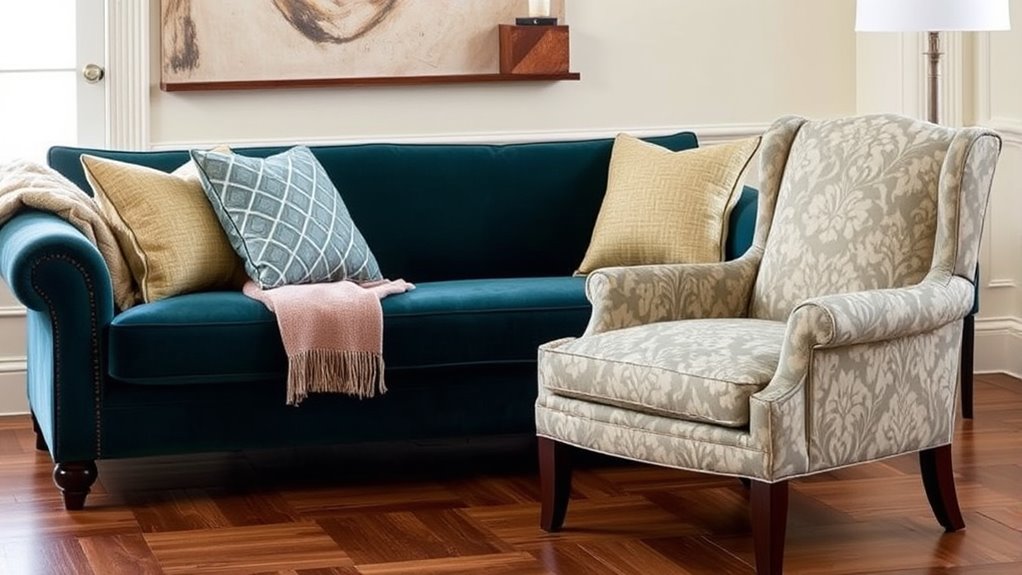
Considering the room’s color scheme is essential when combining patterned fabrics, as it helps create a cohesive and balanced look. Good color coordination ensures that patterns complement each other rather than clash, making the space feel harmonious. Pay attention to the dominant hues and repeat them across different fabrics to unify the design. Incorporate pattern contrast carefully—pair bold patterns with subtler ones to add interest without overwhelming the eye. To achieve this, consider these tips:
- Stick to a consistent color palette for all fabrics
- Mix patterns with similar tones to maintain harmony
- Use neutral backgrounds to highlight vibrant patterns
- Balance large and small patterns to avoid overcrowding
- Understanding Vetted Electric Bike Conversion Kits can inspire creative and functional fabric choices for versatile design solutions.
Incorporate Patterned Fabrics in Small Doses
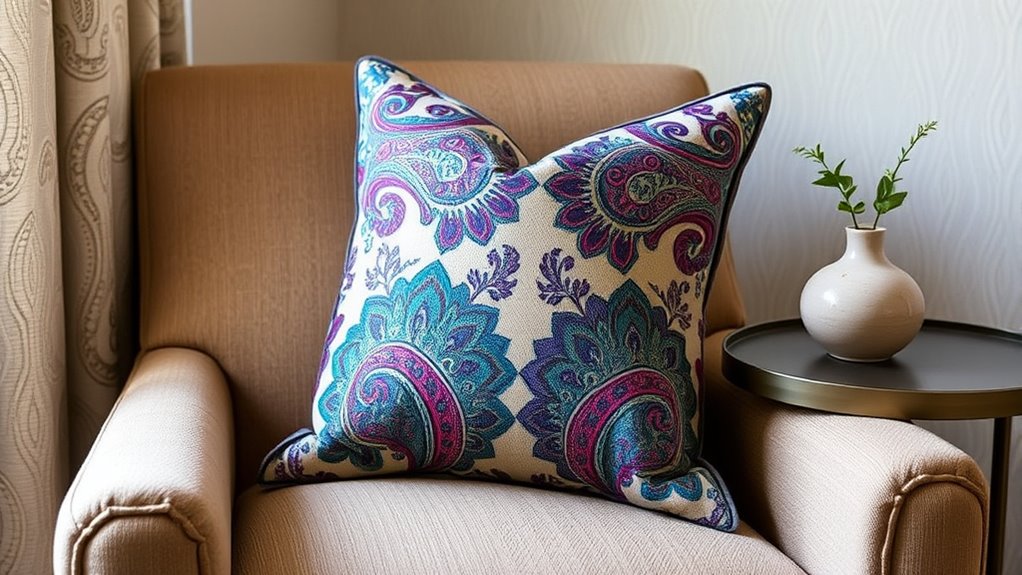
To keep patterned fabrics from overwhelming a space, incorporate them in small doses. Balance busy prints with solids, and choose accent pieces that add visual interest without clutter. Carefully mixing patterns guarantees your room feels lively yet cohesive. When combining different prints, consider residency requirements to ensure your design choices are practical and achievable.
Balance With Solids
Incorporating patterned fabrics into your space becomes more effective when balanced with solid colors. Using solids helps create visual calm and prevents pattern mixing from becoming overwhelming. When selecting fabrics, choose a dominant solid base and add patterned accents sparingly. This approach allows your patterned pieces to stand out without crowding the space. To achieve a cohesive look, coordinate fabrics by sticking to a consistent color palette. Keep these tips in mind:
- Use solids for large furniture pieces or walls to anchor the room
- Limit patterned textiles to small accessories or accent pillows
- Choose patterns with complementary colors for effortless fabric coordination
- Mix different pattern scales carefully to avoid visual chaos
- Color palette coordination is essential for creating harmony when mixing patterns and solids.
Balancing solids with patterned fabrics ensures your design feels intentional and harmonious.
Mix Patterns Carefully
While balancing solids with patterned fabrics creates a harmonious look, mixing patterns themselves requires a thoughtful approach. To avoid pattern clashing, you should limit yourself to two or three patterns in a single space. Focus on fabric coordination by choosing patterns with complementary colors or similar scales. For example, pair a small floral with a bold geometric, ensuring they don’t compete for attention. Keep one pattern as the dominant feature and use the others as accents. When mixing patterns, consider the overall vibe you’re aiming for—uniformity or contrast—and adjust your pattern choices accordingly. Remember, small doses of patterned fabrics can add visual interest without overwhelming your space, making it look lively yet cohesive. Additionally, understanding pattern scales can help you create a balanced and visually appealing arrangement.
Use Accent Pieces
Using patterned fabrics as accent pieces allows you to introduce visual interest without overwhelming your space. Small doses of bold textiles can highlight your style while maintaining balance. When choosing accent fabrics, consider textile durability to ensure they withstand daily use, especially in high-traffic areas. Opt for sustainable fabrics to promote eco-friendly decorating choices. Incorporate patterned pillows, a statement throw, or a decorative chair to add character subtly. These accents can be easily swapped out or changed over time to refresh your look. Remember, less is more; carefully selected accent pieces create focal points without cluttering. Additionally, understanding the financial impact of popular entertainment industries can inspire you to invest in quality fabrics and furnishings that enhance your space’s value and longevity. By thoughtfully using patterned fabrics as accents, you achieve a lively, coordinated space that feels intentional and stylish.
Use Repetition to Establish Cohesion
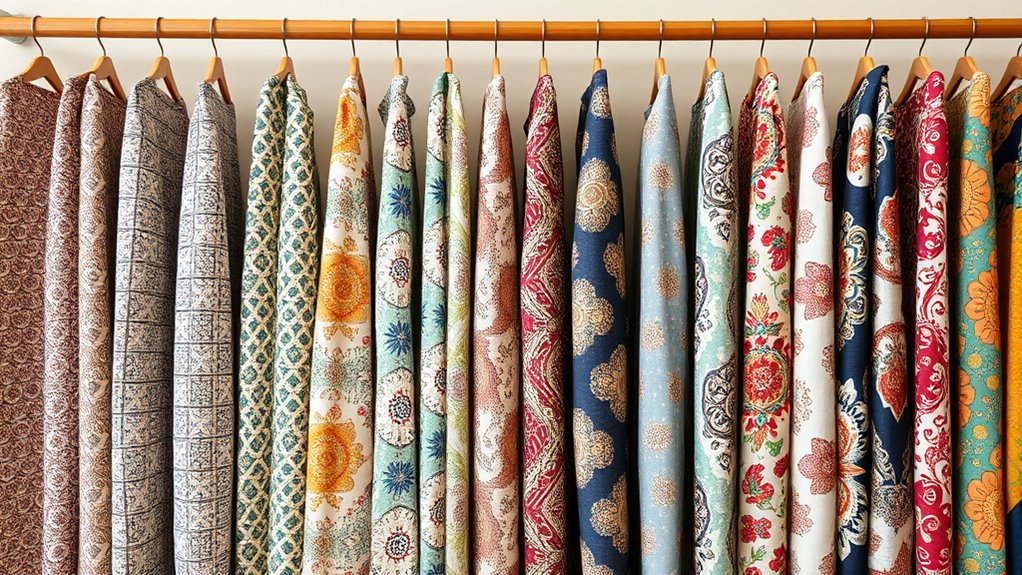
Repetition plays a vital role in creating visual harmony when working with patterned fabrics. By repeating elements like fabric texture and color coordination, you establish a cohesive look that feels intentional and balanced. When patterns share similar hues or textures, it ties different pieces together seamlessly. To deepen this understanding, consider the following:
| Repeated Element | Effect on Cohesion |
|---|---|
| Fabric Texture | Adds tactile uniformity |
| Color Coordination | Creates visual flow |
| Pattern Style | Reinforces thematic unity |
Using these repetitions thoughtfully prevents overcrowding while maintaining interest. Focus on repeating key elements subtly across your space, making sure they complement rather than compete. This approach keeps your design unified and engaging without feeling overwhelming. Incorporating visual harmony principles can help you achieve a more polished and appealing arrangement.
Pay Attention to Pattern Placement and Symmetry
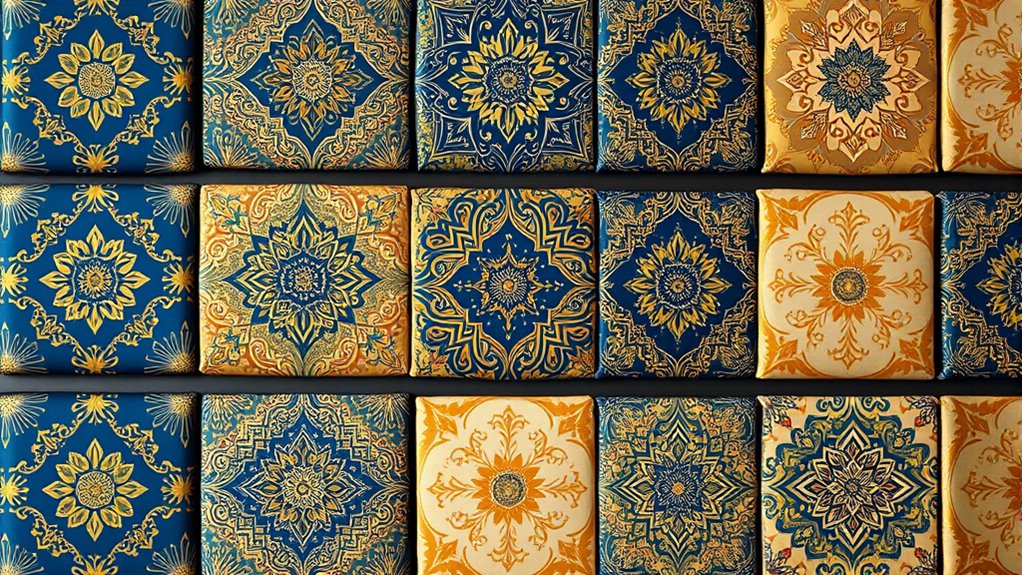
Paying close attention to pattern placement and symmetry guarantees your fabric arrangements look balanced and intentional. Proper pattern alignment ensures motifs line up seamlessly, creating a cohesive visual flow. Symmetry helps distribute visual weight evenly, preventing overcrowding in one area. When arranging fabrics, consider how motif repetition guides the eye across the design, maintaining harmony. Avoid random placement that disrupts the pattern’s rhythm, which can make the space feel chaotic. Instead, align patterns thoughtfully and keep symmetry in mind to enhance aesthetic appeal. This approach allows you to showcase intricate designs without overwhelming the senses. Additionally, understanding visual balance can help you create more harmonious fabric compositions. By carefully managing pattern placement, your fabric choices will look polished, harmonious, and visually engaging.
Edit and Edit Again for a Cohesive Look
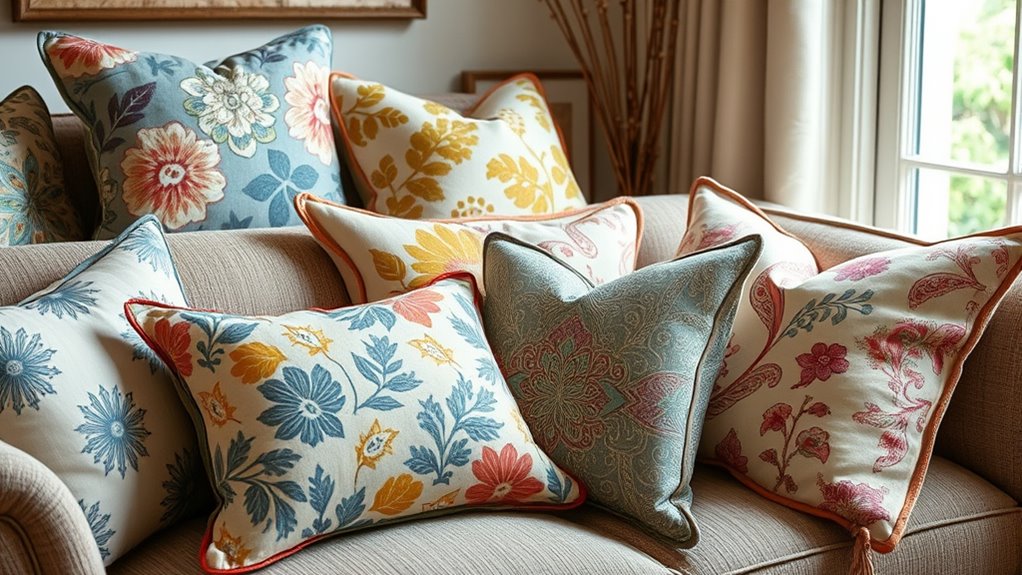
To achieve a cohesive look, it’s essential to edit your fabric arrangements carefully and multiple times. Focus on color coordination by ensuring your fabrics share a common palette or complement each other well. This step helps create harmony and prevents the design from feeling chaotic. Pay attention to fabric contrast—mixing patterns with varying scales and textures adds interest without overcrowding. Remove any pieces that seem out of place or disrupt the flow. Don’t hesitate to step back and review your work with fresh eyes; sometimes, small adjustments can make a big difference. Repeated editing refines your arrangement, making sure each fabric contributes to a unified, balanced aesthetic that feels intentional and not overwhelming. Consulting retail hours can help ensure you visit your favorite stores at the right times to get expert advice or additional supplies if needed.
Frequently Asked Questions
How Do I Choose Patterns That Suit My Personal Style?
To choose patterns that suit your personal style, start by considering your favorite colors and how they coordinate. Mix patterns thoughtfully, balancing bold with subtle designs through pattern mixing. Stick to a cohesive color palette so the combinations don’t clash. Trust your instincts—if you love a print, incorporate it confidently. Keep the overall look balanced by varying scale and pattern types, creating a stylish, personalized outfit without overcrowding.
Can Patterned Fabrics Work in Small Rooms?
Yes, patterned fabrics can work in small rooms if you master pattern mixing and fabric layering. Choose one bold pattern as a focal point, then complement it with smaller, subtler patterns to avoid overcrowding. Layer different textures and fabrics thoughtfully, balancing busy prints with solid colors. This approach adds visual interest without overwhelming the space, making your small room feel lively yet harmonious.
How Do I Prevent Patterns From Clashing Visually?
Prevent pattern clashes by practicing pattern pairing with purpose. You should mix scales thoughtfully, pairing bold, large patterns with subtle, small ones to create contrast and harmony. Establish a clear pattern hierarchy, making sure one design dominates while others complement it. By balancing bold and subtle, large and small, you prevent visual chaos, keeping your space stylish and balanced. Remember, intentional pairing turns chaos into cohesion.
What Are the Best Patterns for a Modern Aesthetic?
You should opt for geometric, minimal, or abstract patterns to achieve a modern aesthetic. When pattern mixing, keep your fabrics coordinated by sticking to a cohesive color palette or similar pattern scales. This approach prevents visual clutter and creates a sleek, contemporary look. Balance bold patterns with solid colors or subtle textures, ensuring your space feels harmonious rather than overcrowded. Focus on clean lines and simple designs for a truly modern vibe.
How Do I Update Patterned Fabrics Over Time?
Think of updating your patterned fabrics like upgrading your vintage tech—timeless, but in need of care. You can refresh your look with subtle pattern mixing, adding new textures or colors gradually. Keep fabric care in mind by washing and storing properly, which prolongs their vibrancy. Over time, swap out or layer in new patterns to keep your space feeling fresh and stylish, like a smart upgrade to your favorite gadget.
Conclusion
By following these tips, you’ll master the art of decorating with patterned fabrics without overwhelming your space. Remember, a well-balanced pattern can make your room feel lively and inviting. Did you know that homes with thoughtfully mixed patterns often feel 30% more dynamic and cozy? So, trust your eye, experiment thoughtfully, and create a stylish, harmonious environment that reflects your personality without the chaos.

